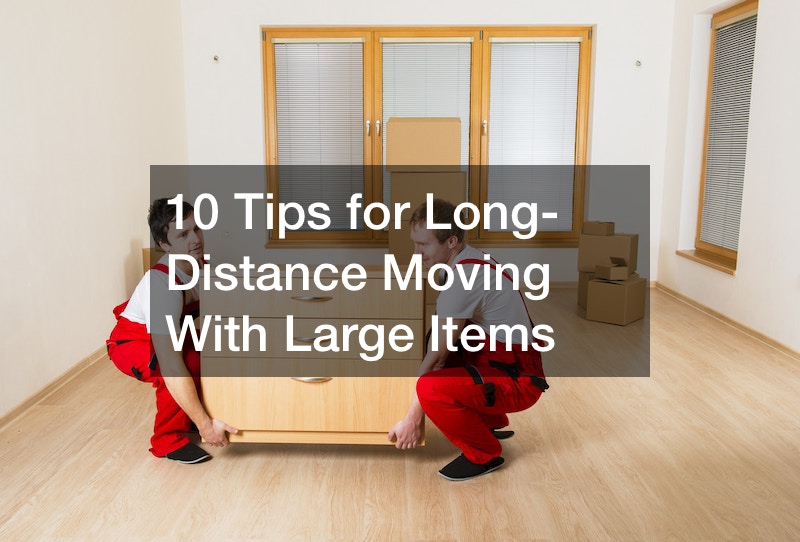You’re getting ready to make a big move, but you also have some big items that must go with you. Before you just start packing away everything, remember that large and heavy objects require a bit more time, energy, and attention. If you’re planning on moving with large items, look here to determine what you need to do to travel safely with any large objects you may want to take with you.
1. Moving Power Sports Equipment
Moving with sizable possessions, like a 4×4 or other power sports equipment, can be daunting, but you can simplify the process with preparation and systematic organization. To begin, compile a detailed inventory of your belongings, paying close attention to each item’s size, weight, and specific handling instructions. Regarding 4x4s or other large equipment, it’s essential to disassemble removable components, minimizing the chances of damage during transit and making the items easier to transport. Also, carefully label these parts so you can reassemble them without any confusion later.
Using specialized moving equipment like dollies and moving straps can be a game-changer when relocating large items. These tools are designed to assist you in maneuvering bulky equipment and securing it in place, ensuring your move is smooth and efficient. Remember, the key to a successful long-distance move with sizable items, like 4x4s or power sports equipment, starts with planning and organization. By following these tips, you’ll be on your way to a hassle-free relocation experience.
2. Draining Fluids From Vehicles
Are you moving with sizable objects like dirt bikes? An essential step in the process is to drain fluids, including gasoline, oil, and coolant, before leaving. Draining the fluids is critical in reducing the possibility of leaks, which could harm your other possessions during the move. Check the owner’s manual for step-by-step instructions to safely and properly remove fluids from your dirt bikes or vehicles. The manual will provide detailed guidance on the correct draining procedures for each fluid to avoid any mishaps.
Once you have successfully drained the fluids, it’s important to dispose of them responsibly. Locate a nearby recycling center that accepts them and transport them there for proper disposal. This environmentally conscious action protects your belongings while in motion and helps preserve the environment by preventing pollution.

3. Managing Large Batteries During a Move
Moving with large items that depend on batteries, like a golf cart for sale, requires proper handling and management of the batteries. To ensure the safety of everyone it’s necessary to disconnect and remove the batteries from your large items. It prevents any damage to the items and protects against accidents caused by a sudden power surge or short circuit.
Once you’ve removed the batteries, find a cool, dry place to store them. It’s important to keep them away from direct sunlight and extreme temperatures, as exposure to these conditions can degrade the batteries’ performance and shorten their lifespan.
In addition, proper storage will help maintain the batteries’ functionality and ensure they’re ready for use when you get where you’re going. During the move, make sure the batteries are properly secured and protected from potential damage. Padding materials like bubble wrap or blankets can cushion them and place them in sturdy boxes. This extra layer of protection will help prevent any harm and avoid possible problems with other belongings in the moving truck.
4. Preparing Boats for a Big Move
Proper preparation is also key to ensuring a smooth and successful transition if you’re tackling a big move involving large items like boats. To start, seek the assistance of a full service outboard dealer who can provide expert tips. Their knowledge will be invaluable in helping you navigate the process.
A necessary step in preparing your boat is to give it a thorough cleaning. Remove any dirt, grime, or debris. This will make the boat more presentable and help identify any areas that may need attention or repairs before the move. Next, remove all personal items which could get damaged. Be sure to secure any loose parts, including accessories.
Additionally, it’s essential to drain all fluids from the boat, including fuel, oil, and coolant, to minimize the risk of spills or leaks. This step, like other large items, helps protect your possessions. Finally, disconnect the boat’s battery to avoid electrical issues. Safely store the battery and ensure it’s secured properly to avoid mishaps.

5. Choosing the Right Boat Cover
Ensuring the safety of your boat during a move is of utmost importance, which is why choosing the right canvas boat covers is just as important. A high-quality boat cover is an investment that will protect your vessel, so it’s important to find one that fits the specific dimensions. When selecting a canvas cover, look for features that enhance durability. For example, a good cover should be water-resistant to shield your boat from rain and other moisture. Additionally, it should have UV protection to prevent sun damage, which could otherwise lead to fading and deterioration over time.
Another important factor to consider is ventilation. A well-ventilated cover helps prevent mold and mildew growth, which could disfigure your boat’s interior and exterior surfaces. In addition, proper ventilation ensures that moisture can escape, preserving the integrity of your boat. Once you’ve chosen the right one, secure it tightly. Use straps, buckles, or drawstrings that come with it, or purchase additional securing materials if necessary. Properly securing the cover will help protect your boat from debris, dirt, and other potential hazards.
6. Packing Up Lawn Equipment
A zero turn mower is a large item you may not be sure about moving with. Proper packing is a crucial part of the process. However, following a few essential steps, you can protect your lawn equipment and make the move seamless. Begin by thoroughly cleaning the zero-turn mower or any other lawn equipment and removing all dirt, grass, and debris that may have accumulated during use. It will make the equipment more presentable and help identify any areas needing attention or repairs before you head out.
Next, drain fluids, including gasoline, oil, and coolant, and take out the battery, just as you would with other large items. Again, you don’t want to arrive and find that there have been spills or electrical issues along the way. Wrap sharp edges or protruding parts with protective material, like bubble wrap or moving blankets. You can save yourself the headache of scratches, dents, or other damage that may occur during transport.
Lastly, consider using specialized moving equipment, like furniture dollies, to assist in loading and unloading lawn equipment. The tools make maneuvering and securing your items easier. In addition, you’re not putting yourself at risk of physical injury by trying to move something that’s awkward and heavy.

7. Moving Lawn Equipment Safely
After you have packed up your lawn equipment, it’s time to think about what needs to be done during the move. Maybe not a lawn mower, but other devices are out there, like bush hogs. Disconnect any attachments or accessories from your equipment to make it more compact and easier to move. Be sure to store these attachments safely, labeling them clearly so you can find and put together your equipment when you arrive.
When loading the moving truck, strategically position your bush hogs and other lawn equipment. What does this mean? You need to place them in a way that evenly distributes the weight, preventing any imbalances that could cause instability, leading to driving hazards. Keep in mind that large items should be placed on the truck floor, avoiding any stacking of other belongings on top of them.
Once you have determined the best layout, use heavy-duty straps or ratchet tie-downs to secure your lawn equipment. The straps are designed to handle heavier weights and will stop any movement while going down the road. It reduces the risk of damage to your equipment or other items in the truck.
To protect the edges and surfaces of lawn equipment from scratches or dents, consider using padding as a protective layer. Wrap them around the equipment and secure them with tape or additional straps. Make sure you don’t cover any moving parts or vents.
Finally, double-check that everything is fastened and in place before you hit the road. Remember to drive cautiously as you embark on your long-distance move, especially when navigating tight turns or bumpy roads. It will keep you safe and ensure the safety of your valuable lawn equipment.
8. Choosing to Sell or Move Equipment
One thing you need to do before finalizing your moving plans is weigh out the pros and cons of transporting certain pieces of equipment, like a log splitter. The decision to move or sell these items can significantly impact the overall experience. By weighing the pros and cons of each option, you can make informed decisions that best suit your needs.
Moving heavy items comes with a range of benefits. By keeping them, you will feel more comfortable in your new place. The sentimental value or long-term usefulness of certain items may outweigh the inconvenience and costs associated with moving them. Furthermore, the time and effort spent searching for replacement items in the new location is avoided.
However, moving heavy items also presents several disadvantages. The process can be challenging and costly, particularly if professional movers are required. Additionally, the risk of damage is increased, which can result in additional expenses or loss of special items. Space constraints in the new home may also make accommodating large or heavy things difficult.
On the other hand, selling heavy items before moving offers advantages. This approach can help reduce hauling costs and simplify the relocation. In addition, selling items provides extra cash to cover expenses or invest in new things better suited to the new living space. Moreover, it can be an opportunity to declutter, leading to a more organized and efficient living environment. Nevertheless, selling heavy items has its downsides, too. The selling process is sometimes time-consuming and may not yield the financial return you expect, especially if the items have depreciated. In addition, the emotional attachment to certain things can make parting with them difficult.

9. Preparing Pressurized Containers for Elevation Changes
When embarking on a long-distance move with large items, like breathing air compressors, it’s essential to be mindful of elevation changes and their impact on pressurized containers. Preparing your equipment correctly can make all the difference in ensuring safe and damage-free transport. Begin by consulting the owner’s manual for your breathing air compressor or other pressurized containers. It will provide specific instructions on safely handling and transporting the equipment.
Before packing the compressor, release any built-up pressure within the container. This step is crucial to prevent potential damage or accidents like an explosion. Elevation changes can cause pressure fluctuations, stressing the container and its seals. When packing the breathing air compressor, ensure it is securely wrapped in protective materials to avoid scratches or dents. Place it strategically within the moving truck, distributing the weight evenly and securing it with heavy-duty straps to prevent movement during the journey.
10. Team Lifting Heavy Items
Team lifting is often necessary and helpful when moving with a kluft mattress or other heavy belongings. Coordinating a well-prepared team can greatly reduce the risk of injury or damage to your possessions, making the move much more manageable. Start by recruiting friends, family members, or even consider hiring professional movers to assist you with handling bulky items. Whichever option you choose, make sure everyone involved is physically capable of lifting and carrying heavy loads.
Before lifting, discuss the proper techniques to avoid injuries. Emphasize the importance of lifting with the legs, not the back, and maintaining good communication. It will help ensure everyone is on the same page about how to carry, maneuver, and place the item safely.
Designate specific roles for everyone, including guiding, lifting, or stabilizing. It will create organization and minimize confusion. Additionally, make certain that the path from your home to the moving truck is clear of obstacles, allowing your team to navigate easily with hefty items in tow.
Moving with large items doesn’t have to be a hassle or stressful. As long as you follow the proper procedures and protocols, you shouldn’t have any issues getting your things from where you are to where you’re going. Remember to keep your safety in mind first and do what’s necessary to protect your prized possessions.


